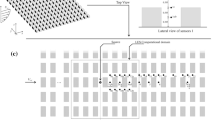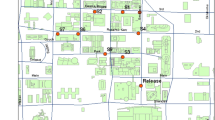Abstract
Statistics are investigated for concentration time series measured with fast-response analyzers during the Joint Urban 2003 experiment in Oklahoma City. Data collected at nine different sites for a total of six 30-min continuous releases were analyzed. After a short description of the measurements and meteorological conditions prevailing during the two chosen intensive observation periods, the variation of mean concentrations, fluctuation intensity, peak-to-mean ratio, concentration percentiles, and intermittency are discussed. High intermittency is only observed at sites close to the edge of the urban plumes. Even though the meteorological conditions during all six releases were quite similar, all concentration parameters generally show great variability. This highlights the difficulty of obtaining representative statistics from full-scale experiments, during which only relatively short time series can be recorded and diurnal variations of weather patterns are typical. In addition to the concentration statistics, the measured cumulative probability (CDF) and exceedance probablity (EDF) functions are compared with two-parametric gamma and 3-parametric clipped-gamma CDFs and EDFs. It can be shown that both gamma distributions agree well with the observations particularly in the upper tail of the distributions, and that realistic 95 and 98 concentration percentiles are predicted for plumes dispersing in an urban environment. The clipped-gamma distribution, which better captures important dispersion physics, performs slightly better for highly intermittent signals but its performance depends on which relationship between intermittency and fluctuation intensity is assumed, and is thus not necessarily a better choice for practical applications. The issues of limited statistical representativeness of the analyzed data is further addressed in a second part of this paper which includes the analysis of wind-tunnel concentration time series.
Similar content being viewed by others
References
United Nations (2007) World urbanization prospects. The 2007 revision. http://www.un.org/esa/population/publications/wup2007/2007WUP_ExecSum_web.pdf. Accessed 26 Aug 2009
Jacobson MZ (2002) Atmospheric pollution. Science and regulation. Cambridge University Press, History, UK
Brunekreef B, Holgate ST (2002) Air pollution and health. Lancet 360(9341): 1233–1242
Klein P, Leitl B, Schatzmann M (2007) Driving physical mechanisms of flow and dispersion in urban canopies. Int J Climatol 27: 1887–1907
Xie XM et al (2005) Impact of building configuration on air quality in street canyon. Atmos Environ 39(25): 4519–4530
Vardoulakis S et al (2003) Modelling air quality in street canyons: a review. Atmos Environ 37(2): 155–182
Britter RE, Hanna SR (2003) Flow and dispersion in urban areas. Annu Rev Fluid Mech 35: 469–496
Allwine KJ, Shinn JH, Streit GE, Clawson KL, Brown M (2002) Overview of urban 2000—a multiscale field study of dispersion through an urban environment. Bull Am Meteorol Soc 83(4): 521–536
Allwine KJ (2004) Overview of JOINT URBAN 2003 - an atmospheric dispersion study in Oklahoma City. AMS symposium on planning, nowcasting, and forecasting in the urban zone, Seattle, WA, Jan 11–15, paper J7.1. http://ams.confex.com/ams/84Annual/techprogram/paper_71468.htm. Accessed 26 Aug 2009
Rotach MW, Gryning SE, Batchvarova E, Christen A, Vogt R (2004) Pollutant dispersion close to an urban surface—the BUBBLE tracer experiment. Meteorol Atmos Phys 87(1–3): 39–56
Rotach MWL et al (2005) BUBBLE—an urban boundary layer meteorology project. Theor Appl Climatol 81(3-4): 231–261
Wood CR et al (2009) Dispersion experiments in central London, The 2007 Dapple Project. Bull Am Meteorol Soc 90(7): 955–970
Hanna S, Baja E (2009) A simple urban dispersion model tested with tracer data from Oklahoma City and Manhattan. Atmos Environ 43(4): 778–786
Hanna S et al (2008) Evaluation of the Hazard Prediction and Assessment Capability (HPAC) model with the Oklahoma City Joint Urban 2003 (JU2003) tracer observations. Air Pollut Model Appl Xix: 63–71
Hanna S et al (2007) Observed winds, turbulence, and dispersion in built-up downtown areas of Oklahoma City and Manhattan. Boundary-Layer Meteorol 125: 441–468
Dyster SJ et al (2001) Turbulent fluctuations and their use in estimating compliance with standards and in model evaluation. 2001, vol 16/Inderscience Enterprises Ltd, City, pp 57–68
NRC (National Research Council): (2003) Tracking and predicting the atmospheric dispersion of hazardous material releases—implications for homeland security. National Academies Press, Washington, DC
Aubrun S, Leitl B (2004) Unsteady characteristics of the dispersion process in the vicinity of a pig barn. Wind tunnel experiments and comparison with field data. Atmos Environ 38(1): 81–93
Chatwin PC (1982) The use of statistics in describing and predicting the effects of dispersing gas clouds. J Hazard Mater 6(1–2): 213–230
Kastner-Klein P, Leitl B, Pascheke F, Schatzmann M (2004) Wind-tunnel simulation of the JOINT Urban 2003 tracer experiment. AMS symposium on planning, nowcasting, and forecasting in the urban zone, Seattle, WA, Jan 11–15, paper 5.4. http://ams.confex.com/ams/84Annual/techprogram/paper_73272.htm. Accessed 26 Aug 2009
Klein P, Leitl B, Schatzmann M (2010) Concentration fluctuations in a downtown urban area—part II: analysis of joint urban 2003 wind-tunnel measurements. Environ Fluid Mech doi:10.1007/s10652-010-9195-7
Hanna SR (1984) The exponential probability density function and concentration fluctuations in smoke plumes. Boundary-Layer Meteorol 29: 361–375
Lewellen WS, Sykes RI (1986) Analysis of concentration fluctuations from LIDAR observations of atmospheric plumes. J Clim Appl Meteorol 25(8): 1145–1154
Sawford BL (1987) Conditional concentration statistics for surface plumes in the atmospheric boundary-layer. Boundary-Layer Meteorol 38(3): 209–223
Yee E (1990) The shape of the probability density-function of short-term concentration fluctuations of plumes in the atmospheric boundary layer. Boundary-Layer Meteorol 51(3): 269–298
Mylne KR, Mason PJ (1991) Concentration fluctuation measurements in a dispersing plume at a range of up to 1000 m. Q J R Meteorol Soc 117(497): 177–206
Mylne KR (1993) The vertical profiles of concentration fluctuations in near-surface plumes. Boundary-Layer Meteorol 65(1–2): 111–136
Yee E et al (1993) Probability-distributions of concentration fluctuations of a weakly diffusive passive plume in a turbulent boundary layer. Boundary-Layer Meteorol 64(4): 321–354
Weil JC et al (2002) Experiments on buoyant plume dispersion in a laboratory convection tank. Boundary-Layer Meteorol 102(3): 367–414
Ma YM et al (2005) Plume dispersion from the MVP field experiment. Analysis of surface concentration and its fluctuations. Atmos Environ 39(17): 3039–3054
Davidson MJ et al (1995) Plume dispersion through large group of obstacles—a field investigation. Atmos Environ 29(22): 3245–3256
Yee E, Biltoft CA (2004) Concentration fluctuation measurements in a plume dispersing through a regular array of obstacles. Boundary-Layer Meteorol 111(3): 363–415
Davidson MJ et al (1996) Wind tunnel simulations of plume dispersion through groups of obstacles. Atmos Environ 30(22): 3715–3731
Gailis RM, Hill A (2006) A wind-tunnel simulation of plume dispersion within a large array of obstacles. Boundary-Layer Meteorol 119(2): 289–338
Yee E et al (2006) Comparison of wind-tunnel and water-channel simulations of plume dispersion through a large array of obstacles with a scaled field experiment. Boundary-Layer Meteorol 121(3): 389–432
Mylne KR (1992) The PDF of concentration fluctuations—comments on Yee (1990) and Yee (1991). Boundary-Layer Meteorol 61(1–2): 189–193
Yee E, Chan R (1997) A simple model for the probability density function of concentration fluctuations in atmospheric plumes. Atmos Environ 31(7): 991–1002
Yee E (2009) Probability law of concentration in plumes dispersing in an urban area. Environ Fluid Mech 9(4): 389–407
Chatwin PC, Sullivan PJ (1989) The intermittency factor of sclars in turbulence. Phys Fluids A 1(4)
Allwine KJ, Flaherty JE (2004) Joint Urban 2003: study overview and instrument locations. Report PNNL-15967, Prepared for the U.S. Department of Homeland Security under a Related Services Agreement with the U.S. Department of Energy under contract DE-AC05-76RL01830. http://www.ntis.gov/ordering.htm
Clawson KL, Carter RG, Lacroix DJ et al (2005) Joint Urban 2003 (JU03) SF6 atmospheric tracer field tests. NOAA Technical Memorandum OAR ARL-254
Doran JC et al (2007) Characteristics of puff dispersion in an urban environment. Atmos Environ 41(16): 3440–3452
De Wekker SFJ, Berg LK, Allwine KJ et al (2004) Boundary-layer structure upwind and downwind of Oklahoma City during the Joint Urban 2003 field study. In: Paper presented at the 5th AMS conference on the urban environment, Paper 3.20, Vancouver, BC, Canada, August 23–26
Klein P, Clark JV (2007) Flow variability in a north American downtown street canyon. J Appl Meteorol Climatol 46(6): 851–877
Lundquist JK, Shinn JH, Gouveia F (2004) Observations of turbulent kinetic energy dissipation rate in the urban environment. AMS symposium on planning, nowcasting, and forecasting in the urban zone, Seattle, WA, Jan 11–15, paper J7.6. http://ams.confex.com/ams/84Annual/techprogram/paper_71468.htm. Accessed 26 Aug 2009
De Wekker SFJ (2003) Data sets from the JU2003 PNNL sodar measurements. Personal communication
Author information
Authors and Affiliations
Corresponding author
Rights and permissions
About this article
Cite this article
Klein, P.M., Young, D.T. Concentration fluctuations in a downtown urban area. Part I: analysis of Joint Urban 2003 full-scale fast-response measurements. Environ Fluid Mech 11, 23–42 (2011). https://doi.org/10.1007/s10652-010-9194-8
Received:
Accepted:
Published:
Issue Date:
DOI: https://doi.org/10.1007/s10652-010-9194-8




